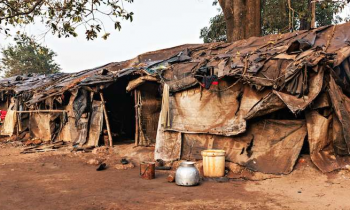Suriyanarayanan Sarvajayakesavalu
Abstract
As the Millennium Development Goals (MDGs) deadline approaches, UN member states have established a new, universal set of goals, i.e., Sustainable Development Goals (SDGs), to develop a global vision for sustainable development, balancing economic growth, social development, and environmental protection over the next fifteen years. There is a need to give specific attention, dependent on the capacities of nations and other national circumstances, to the different goals and targets. Focused guidelines and priorities are essential requirements for the achievement of the SDGs. The five priorities for the SDGs proposed by Lu et al. (2015) are of great significance to the participating communities, as they present the right directions for the proper functioning of the Sustainable Development Goals. There will be significant challenges for developing countries to put the five priorities into practice, depending on their policies and other national settings. This article addresses the major challenges that may be faced by developing nations when implementing the SDGs.
Introduction
There are big debates over the achievement of the Millennium Development Goals (MDGs) because of broader measures of human development, especially the divide between the promotion of human welfare and development objectives, and economic growth, political failures, and so on. As the deadline for the MDGs approaches in 2015, attention has turned to the Sustainable Development Goals (SDGs), with a new vision for development. In response to growing concern about worldwide sustainable development and to determine future development over next 20 years, the SDGs are considered potential guidelines to move the world toward a sustainable future.
The SDGs are expected to do better than the MDGs. The shortcomings of MDGs, such as data delays and lack of priorities, are some of the important gaps to be considered when planning for effective SDGs implementation. Focused guidelines and priorities are essential requirements for the achievement of the SDGs. The five priorities proposed by Yonglong Lu et al. (2015) are important and needed by the participating communities for the proper functioning of the Sustainable Development Goals, as they are very precise and give clarifications for better understanding and implementation of the SGDs. Each country faces specific challenges to implement the SDGs, and these priorities will play a significant role in their success. The priorities Lu et al. (2015) propose are as follows: devise metrics, establish monitoring mechanisms, evaluate progress, enhance infrastructure, and standardize and verify data.
Adopting these priorities has become a grand challenge in developing nations due to differing national contexts. In this paper, some of the specific challenges that will be faced when implementing these priorities are addressed.
Challenges for Devising Metrics
Among the priorities, metric devising is the core, as it provides an informational tool for the SDGs. Metrics should be simple and easily understood by the community who uses and implements them. As Lu et al. (2015) rightly point out, terms such as sustainable, efficient, and substantial need to be defined quantitatively. Care should be taken when developing the parameters, keeping in mind the potential inequality of a country’s position. A designed set of practical indices for goals, targets, and progress‐monitoring indicators can be prepared for tracking progress on each of the SDGs. These metrics need to be updated periodically to take into account the present situation and practical experiences.
Quantitative targets can help measure the tracking progress of SDGs. Indicators will be the backbone of monitoring the progress of SDGs. The indicators proposed by the Sustainable Development Solutions Network (SDSN), accompanied by suggestions for complementary national indicators, will help track the progress of SDGs. Each country should pick the number and range of complementary national indicators that best suits their needs and capacity to collect and analyze data (SDSN 2015). For developing countries, a set of sub‐goals, along with cross‐cutting and interlinked objectives, have to be considered for successful implementation of the SDGs (Bakshi and Kumar 2013).
Essentials for Establishing Monitoring Mechanisms
A monitoring framework should be established through a global collaboration between governments and scientific bodies assisting developing and underdeveloped nations for the successful implementation of the SDGs. Careful monitoring and evaluation will help identify whether and to what extent such efforts are successful.
Consolidated indicators should be clearly explained, so that data providers and other statistical organizations can report them clearly. For example, the Convention on Biodiversity created an extensive list of indices, and using these indicators as a way of monitoring a country’s progress will be beneficial in multiple ways. These indices are well established and have organizations that are already dedicated to their continued use. They have proven to be a quantifiable method of tracking biodiversity, and using these indices is a good way to monitor progress (CBD 2015).
In developing nations, the gathering and communication of biodiversity information is fragmented. Countries should give priority to existing responsible institutions to build the capacity to develop biodiversity indicators and related metrics to enable effective decision making (Biodiversity Indicator Partnership 2010). To eliminate disparities and maintain equity while tracking progress, a unified survey database package like DevInfo should be developed to monitor the progress of SDGs.
Measures to Evaluate Progress
Establishing monitoring and evaluation processes will provide measurable outcomes, enabling countries to meet the SDGs within the time frame. Developing countries should design the national‐level planning and review mechanisms for successful implementation of SDGs. In order to ensure success, developing nations should pass legislation related to the SDGs.
In developing nations, an action plan should be drawn, with the inclusion of deadlines for the assessment of progress. These deadlines will force the respective states to report their progress toward the SDGs. Assessment should be conducted periodically. Much like existing global assessments, such as UNEP’s Global Environment Outlook and the Millennium Ecosystem Assessment, the SDG’s evaluation process should take place at multiple scales from a distributed network, where cross‐scale learning and coordination is important (Cash 2000, Beisheim et al. 2015).
Problems for Enhancing Infrastructure
Lu et al. (2015) bring up some valuable points on enhancing infrastructure. Challenges, such as the lack of fully developed infrastructure to support networking, high‐performance computing, and the use of GIS, the lack of manpower to operate and support a database management system, and the absence of policies regarding infrastructure in developing nations and underdeveloped countries, will become indicators of inability for the SDGs. It was meticulously and rightly pointed out by the authors that developing countries will need to collaborate with developed countries to build capacity.
In developing countries, the available data has not been greatly used by decision makers, and lack of awareness and insufficient information are the root causes of poor decision‐making. The introduction of GIS technology is encouraging, as it will help decision makers to analyze and integrate spatial data for effective planning and good decision‐making. GIS has been widely used for scientific research and monitoring of natural resources, land‐change patterns, and disaster management, etc. A number of geoinfomation initiatives have been launched by developing countries in the last two decades, but the application of GIS in developing countries is still in its infancy and requires more manpower.
Obtaining mapping data from developing countries has become a challenge. For example, developing spatial coverage of disaster monitoring and management in developing countries is difficult due to lack of ground‐observation networks, high expenses, and the difficulty in accessing mountainous areas. Analysis of remote‐sensing data, satellite‐based observation technology, and expensive high‐resolution geospatial products are not feasible for developing countries; hence, these countries have to depend on external sources. In order to integrate geospatial information infrastructure and data collection into an official reporting system, developing countries must invest in small, core, geospatial divisions, ensuring adequate human capacity, equipment, and software and policy frameworks (Alex 2015).
As Lu et al. (2015) point out, government investments are needed for tracking changes on a large scale, such as land use and land cover change, climate change and impacts, and natural resources management. Therefore, the availability of technology and the development of infrastructure is considered one of the essential building blocks for the successful implementation of the SDGs.
Tasks for Standardizing and Verifying Data
As Lu et al. (2015) state in regard to prioritizing the standardization and verification of data, all SDG data must be open access and released as soon as possible. To avoid a lack of standards, measures should be taken by individual nations to improve the national coordination among authorities monitoring the data and reporting to the international community.
In order to successfully standardize and verify data, four major issues should be addressed: data availability, data quality, data gaps, and differences in data between national and international sources. As the MDG process showed, a few countries stayed on track for reporting the standard data. By contrast, alarming issues, such as poor reporting, differences between country standards and methods, and variations in metadata, hampered many developing countries. For example, 71 countries are identified as possessing insufficient data or no data for measuring their progress toward eradicating hunger, as proposed by MDG 1 (UN Millennium Project 2005).
To overcome this issue, the capacities of nations to collect and report national statistics should be strengthened and should comply with international standards. National Statistical Offices (NSOs) and regional and global statistical bodies can form a working group to give an in‐depth review of data availability, data gaps, and discrepancies in the data at the national level, followed by regional level. Standardization of terminology and estimation methods are important and should adhere to international‐level standards so that comparison with other counties will become easy.
A common platform for data gathering should be established. Sharing data through an open‐source system is a user‐friendly method to encourage transparency in data reporting. For that purpose, initiatives should be established to support data gatherers by using a multilingual system. Opportunities should be given to student communities to do data gathering in support of SDGs. Orientation and training programs would need to be organized to teach the students to work together for successful survey analysis, regular updating, and monitoring.
Lack of coordination between different data sources, the international organization, and NSOs results in inconsistency and a lack of standards in data quality. Identification of potential sources for data is of primary importance. For example, data producers may be different for different ministries in developing countries. Care needs to be taken to identify potential sources for collecting data so that the data provided to NSOs and international agencies do not have differences and contradictory information.
Decreasing international funding for data collection, especially population census and major surveys, in developing countries remains a major challenge. As mentioned by Lu et al. (2015), governments and corporations need to commit to long‐term funding for updating surveys, census taking, drafting questionnaires, computerization, analysis of results, and making available results to ease decision making. Government and NGO reports should be reviewed by a proposed body, which would identify gaps and issues to be rectified in order to eliminate inequities in the data. Providing more transparency, along with consultations by international organizations, will help developing nations measure the indicators. Adequate financial aid and support mechanisms should be provided by developed countries to help the developing and underdeveloped countries meet the SDG targets.
Conclusion
It is an undeniable fact that scientists need to support the SDGs in order to integrate monitoring and evaluation mechanisms into policymaking, and thus to achieve sustainability and support for human life. The five priorities outlined here have clearly illustrated how to integrate the goals, presented step‐by‐step objectives for implementing SDGs, and shown how the SDGs can be implemented by all countries, giving particular focus to developing countries, with right action and a holistic approach that well balances economic, social, and environmental aspects. Developing countries will need to address the challenges of implementing the SDGs carefully if they want to come to the right track for achieving sustainability.
Retrieved from: http://www.tandfonline.com/doi/full/10.1890/EHS15-0028.1


